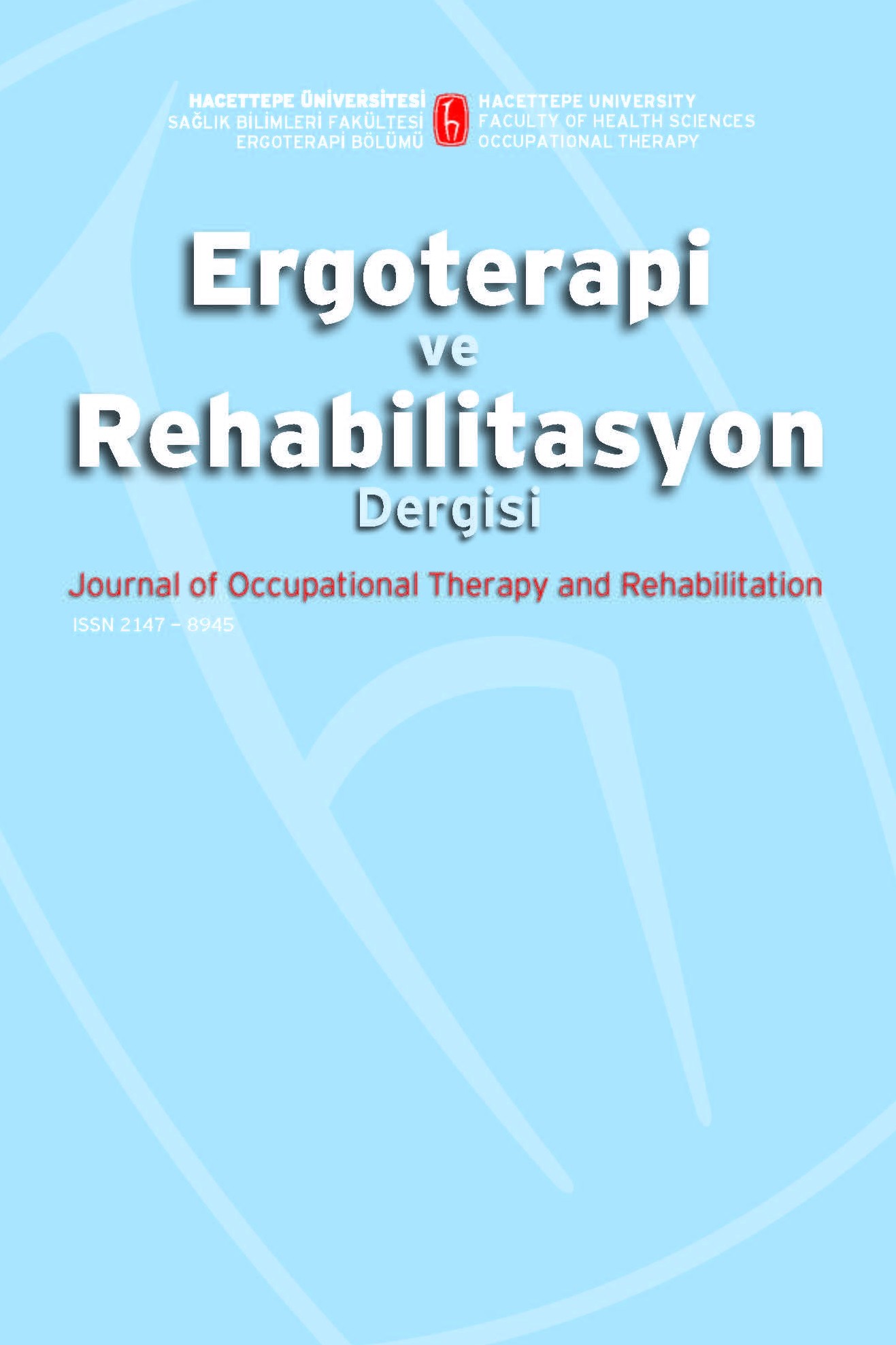Toplumsal Katılım ve Ergoterapi
toplumsal katılım, iş ve uğraşı terapisi, rehabilitasyon
Community Participation and Occupational Therapy
: community participation, occupational therapy, rehabilitation,
___
- Blake, K. (1995). The social isolation of young men with quadriplegia. Rehabilitation Nursing, 20(1), 17-22.
- Cardol, M., de Haan, R. J., de Jong, B. A., Van den Bos, G. A., & de Groot, I. J. (2001). Psychometric properties of the Impact on Participation and Autonomy Questionnaire. Archives of physical medicine and rehabilitation, 82(2), 210-216.
- Chitambo, B., Smith, J., & Ehlers, V. J. (2002). Strategies for community participation in developing countries. Curationis, 25(3), 76-83.
- Christiansen, C., Baum, C. M., & Bass-Haugen, J. (2005). Occupational therapy: Performance, participation, and well-being: Slack Incorporated.
- Doll, J. D. (2010). Program development and grant writing in occupational therapy: Making the connection: Jones & Bartlett Publishers.
- Elliott, S., O'Neal, S., & Velde, B. P. (2001). Using Chaos Theory to Understand a Community-Built Occupational Therapy Practice. Occupational Therapy in Health Care, 13(3-4), 101-111.
- Fidler, G. S. (2001). Community practice: It's more than geography. Occupational Therapy in Health Care, 13(3-4), 7-9.
- Herzberg, G., & Finlayson, M. (2001). Development of occupational therapy in a homeless shelter. Occupational Therapy in Health Care, 13(3-4), 131-144.
- Idler, E. L., & Kasl, S. V. (1997). Religion among Disabled and Nondisabled Persons I: Cross-sectional Patterns in Health Practices, Social Activities, and Well-being Ellen. The Journals of Gerontology Series B: Psychological Sciences and Social Sciences, 52(6), S294-S305.
- Jensen, G. M., & Royeen, C. B. (2002). Improved rural access to care: dimensions of best practice. Journal of Interprofessional Care, 16(2), 117-128.
- Jette, A. M., Keysor, J., Coster, W., Ni, P., & Haley, S. (2005). Beyond function: predicting participation in a rehabilitation cohort. Archives of physical medicine and rehabilitation, 86(11), 2087-2094.
- Kretzmann, J. P., & McKnight, J. (1993). Building communities from the inside out: Center for Urban Affairs and Policy Research, Neighborhood Innovations
- Law, M. (2002). Participation in the occupations of everyday life. American journal of occupational therapy, 56(6), 640-649.
- World Health Organization (2001). International classification of functioning, disability and health: ICF: Geneva: World Health Organization.
- Reed, K. L., & Sanderson, S. N. (1999). Concepts of occupational therapy: Lippincott Williams & Wilkins.
- Rodger, S., & Ziviani, J. (2006). Children, their environments, roles and occupations in contemporary society.
- Roley, S. S., Barrows, C. J., Susan Brownrigg OTR, L., Sava, D. I., Vibeke Talley Otr, L., Kristi Voelkerding, B., . . . Deborah Lieberman, M. (2008). Occupational therapy practice framework: domain & process 2nd edition. The American journal of occupational therapy, 62(6), 625.
- Scaffa, M. E., Sasse, C. S., & Reitz, S. (2014). Public health, community health, and occupational therapy. ME Scaffa & SM Reitz Occupational therapy in community-based practice settings, 19-30.
- Shernoff, D. J., Csikszentmihalyi, M., Schneider, B., & Shernoff, E. S. (2014). Student engagement in high school classrooms from the perspective of flow theory. In Applications of flow in human development and education (pp. 475-494): Springer.
- Smith, B. J., Tang, K. C., & Nutbeam, D. (2006). WHO health promotion glossary: new terms. Health promotion international, 21(4), 340-345.
- Söderback, I. (2009). Occupational Therapy: Emphasis on Clinical Practice. In International handbook of occupational therapy interventions (pp. 13-35): Springer.
- Wilcock, A. A. (2006). An occupational perspective of health: Slack Incorporated.Wittman, P. P., & Velde, B. P. (2001). Occupational therapy in the community: What, why, and how. Occupational Therapy in Health Care, 13(3-4), 1-5.
- ISSN: 2147-8945
- Yayın Aralığı: Yılda 3 Sayı
- Başlangıç: 2013
- Yayıncı: Hacettepe Üniversitesi Sağlık Bilimleri Fakültesi
Levent SENNAROĞLU, Hülya KAYIHAN, Songül AKSOY, Merve Özbal BATUK
Gerçekten Erişilebilir Mi? Okul Erişilebilirliği Hakkında Nitel Bir Çalışma
Sinem KARS, Hülya KAYIHAN, Meral HURİ, Gonca BUMİN
ACTIVLIM Ölçeği’nin Rasch Analizi ile Nöromusküler Hastalıklarda Türkçe Adaptasyonu
Muhammed KILINÇ, Derya GÖKMEN, Cevher DEMİRCİ, İpek GÜRBÜZ, Öznur TUNCA YILMAZ, Sibel AKSU YILDIRIM, Çiğdem ÖKSÜZ, Hatice ABAOĞLU
Ruhsal Hastalıklarda Gevşeme Eğitiminin Ağrı, Yorgunluk Ve Uyku Üzerine Etkisinin İncelenmesi
Zeynep KOLİT, Gamze EKİCİ, A.elif ANIL YAĞCIOĞLU
Is It Really Accessibility: A Qualitative Study About School Accessibility
Gonca BUMİN, Sinem KARS, Meral HURİ, Hülya KAYIHAN
Turkish Adaptation of ACTIVLIM Questionnaire in Neuromuscular Diseases by Rasch Analysiz
Muhammed KILINÇ, Çiğdem ÖKSÜZ, Derya GÖKMEN, İpek GÜRBÜZ, Cevher DEMİRCİ, Hatice ABAOĞLU, Sibel AKSU YILDIRIM, Öznur TUNCA YILMAZ
Toplumsal Katılım ve Ergoterapi
Mine UYANIK, Onur ALTUNTAŞ, Berkan TORPİL
Otizmin Basılı Medyada Temsili: Ulusal Eylem Planından Sonraki Sürecin İncelenmesi
